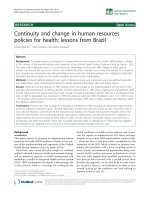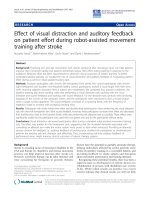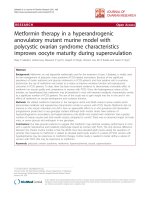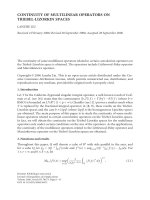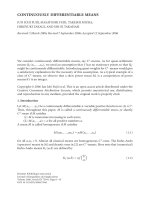Báo cáo y học: "Continuous Non-Invasive Arterial Pressure Technique Improves Patient Monitoring during Interventional Endoscopy"
Bạn đang xem bản rút gọn của tài liệu. Xem và tải ngay bản đầy đủ của tài liệu tại đây (1.17 MB, 6 trang )
Int. J. Med. Sci. 2009, 6
37
I
I
n
n
t
t
e
e
r
r
n
n
a
a
t
t
i
i
o
o
n
n
a
a
l
l
J
J
o
o
u
u
r
r
n
n
a
a
l
l
o
o
f
f
M
M
e
e
d
d
i
i
c
c
a
a
l
l
S
S
c
c
i
i
e
e
n
n
c
c
e
e
s
s
2009; 6(1):37-42
© Ivyspring International Publisher. All rights reserved
Research Paper
Continuous Non-Invasive Arterial Pressure Technique Improves Patient
Monitoring during Interventional Endoscopy
Sylvia Siebig
, Felix Rockmann, Karl Sabel, Ina Zuber-Jerger, Christine Dierkes, Tanja Brünnler and
Christian E. Wrede
Department of Internal Medicine I, University of Regensburg, Germany
Correspondence to: Sylvia Siebig, MD, Department of Internal Medicine I, University of Regensburg, D-93042 Regens-
burg, Germany, Tel.: +49-941/944-7010; Fax: +49-941/944-7021; E-Mail:
Received: 2008.11.17; Accepted: 2009.01.10; Published: 2009.01.20
Abstract
Introduction: Close monitoring of arterial blood pressure (BP) is a central part of cardio-
vascular surveillance of patients at risk for hypotension. Therefore, patients undergoing di-
agnostic and therapeutic procedures with the use of sedating agents are monitored by dis-
continuous non-invasive BP measurement (NIBP). Continuous non-invasive BP monitoring
based on vascular unloading technique (CNAP®, CN Systems, Graz) may improve patient
safety in those settings. We investigated if this new technique improved monitoring of pa-
tients undergoing interventional endoscopy.
Methods: 40 patients undergoing interventional endoscopy between April and December
2007 were prospectively studied with CNAP® in addition to standard monitoring (NIBP,
ECG and oxygen saturation). All monitoring values were extracted from the surveillance
network at one-second intervals, and clinical parameters were documented. The variance of
CNAP® values were calculated for every interval between two NIBP measurements.
Results: 2660 minutes of monitoring were recorded (mean 60.1±34.4 min/patient). All pa-
tients were analgosedated with midazolam and pethidine, and 24/40 had propofol infusion
(mean 90.9±70.3 mg). The mean arterial pressure for CNAP® was 102.4±21.2 mmHg and
106.8±24.8 mmHg for NIBP. Based on the first NIBP value in an interval between two NIBP
measurements, BP values determined by CNAP® showed a maximum increase of
30.8±21.7% and a maximum decrease of 22.4±28.3% (mean of all intervals).
Discussion: Conventional intermittent blood pressure monitoring of patients receiving se-
dating agents failed to detect fast changes in BP. The new technique CNAP® improved the
detection of rapid BP changes, and may contribute to a better patient safety for those un-
dergoing interventional procedures.
Key words: continuous non-invasive blood pressure, procedural sedation, endoscopy, cardiovas-
cular monitoring, hypotension.
Introduction
Cardiovascular complications including ar-
rhythmia, ischemia and hypotension during inter-
ventional endoscopy, are not common, but neverthe-
less higher than previously reported, and may cause
harm to patients [1, 2]. In elderly patients and in those
with compromised cardiovascular function even short
episodes of hypotension may cause extensive prob-
lems. Hence close monitoring of the arterial blood
pressure (BP) is a central part of cardiovascular sur-
veillance in these patients. Theoretically, this is guar-
anteed at best by invasive monitoring with an in-
tra-arterial catheter, but this would put patients at risk
Int. J. Med. Sci. 2009, 6
38
for adverse events like infections or necrosis. There-
fore, patients undergoing diagnostic and therapeutic
procedures with the use of sedating agents are moni-
tored by discontinuous non-invasive BP measurement
(NIBP) with measure intervals between 3 to 15 min-
utes as standard. However, hypotensive episodes
may be missed between these intervals. One possible
solution may be the application of a new technique of
continuous non-invasive BP monitoring by CNAP®
(CN Systems, Graz, Austria) in those settings.
CNAP® is based on the vascular unloading technique
and enables a beat-to-beat BP measurement without
having substantial negative side effects [3, 4]. We
compared test readings from NIBP and CNAP® val-
ues in patients undergoing interventional endoscopy
such as endoscopic retrograde cholangiopancrea-
tography (ERCP). The aim of this study was to inves-
tigate the accuracy of NIBP measurements in these
patients, and if cardiovascular patient monitoring in
interventional endoscopy could be improved by
CNAP®.
Methods
Study design
The prospective study took place between April
and December 2007 on patients undergoing interven-
tional endoscopy. The study was approved by the
ethics committee of the University of Regensburg and
performed in accordance with the declaration of Hel-
sinki.
Patients
40 patients undergoing interventional endo-
scopy were monitored by CNAP® in addition to
standard monitoring (NIBP, ECG and oxygen satura-
tion). Patients with peripheral vascular pathology like
vascular implants and raynaud syndrome were ex-
cluded. All patients were treated with analgosedative
medication and were asked to limit their arm move-
ments.
Monitoring values were extracted from the sur-
veillance network at one-second intervals by using
e-data® software (Draeger medical solutions, Lübeck,
Germany). Additionally clinical and demographical
parameters were recorded.
Materials
Continuous non-invasive BP monitoring based
on vascular unloading technique (CNAP®, CN Sys-
tems, Graz, Austria) is commercially available since
2007. It can be used in combination with Task Force
Monitor® (CN Systems, Graz, Austria) or with Drae-
ger (Draeger Medical, Lübeck, Germany) and Siemens
Monitors (Siemens Erlangen, Germany). The method
is based on concentrical interlocking control loops for
correct long-term tracing of finger BP, including
automatic set point adaption, light control and sepa-
rate inlet and outlet valves for electric-pneumatic
control [3, 4]. The cuff pressure is continuously
changed through the systolic and diastolic blood
pressure cycle to keep the finger’s luminescence con-
stant. Therefore, the cuff pressure corresponds to the
pressure in the finger at any time. CNAP® is cali-
brated by standard NIBP via upper arm’s cuff.
Figure 1 shows the double-finger cuff, placed at
patient’s middle and index finger or middle and ring
finger; respectively. The cuff is connected with the
cuff controller and the monitoring device.
Figure 1. Interventional endoscopy
in our gastroenterological depart-
ment; in the left corner the CNAP®
double-finger module is highlighted.
Int. J. Med. Sci. 2009, 6
39
Statistic analysis
Data collection and statistical calculations were
performed using Microsoft Office Access (Version
2007, Microsoft Corporation, Redmond, USA) and
SPSS® (SPSS inc, Version 15, Germany). Data are ex-
pressed as mean + SD.
Results
Patients
24 female and 16 male patients, with an average
age of 59±15 years underwent 32 ERCPs and 8 other
interventional endoscopies with a mean duration of
66 minutes ± 34 minutes. Indications leading to en-
doscopy were: malignant stenosis of the hepatic duct
(n=13), cholelithiasis (n=8), benign stenosis of the
hepatic duct (n=6), pancreati-
tis/pancreas-pseudocysts (n=4), others (n=8). All pa-
tients (mean BMI 25 kg/m²) received midazolam
(7.4±3.3 mg) and pethidin (52.5±19.2 mg), 24 patients
were additionally treated with propofol (90.9±70.3
mg) and 2 patients with ketamine (100.0±50.0 mg). No
cardiovascular complications following endoscopy
were detected.
NIBP and CNAP® values
2660 minutes of monitoring were recorded.
Within this time 103 117 CNAP® and 333 NIBP
measurements were recorded. Furthermore, we rec-
ognized 143 088 heart rate values and 145 665 oxygen
saturation values.
The mean NIBP arterial pressure was
106.82±24.82 mmHg (mean arterial pressure). On av-
erage, 10.3 NIBP measurements were performed per
endoscopy. The mean arterial pressure values deter-
mined by CNAP® were 102.37±21.20 mmHg and
therefore not significantly different from the mean
NIBP values.
In order to determine blood pressure changes
undetected by conventional NIBP surveillance, NIBP
intervals were defined as the time space between two
adjacent NIBP measurements, and the CNAP read-
ings within these intervals were analyzed (figure 2). In
total, 254 NIBP intervals were calculated with a mean
length of 7.5±4.6 minutes.
Figure 2. The variance of
CNAP® values for every NIBP
interval based on the first NIBP
value
Int. J. Med. Sci. 2009, 6
40
Using standard cardiovascular monitoring, a
NIBP value is presumed to reflect the patient’s blood
pressure until a second value is available. Therefore,
we calculated the variance of CNAP® values for every
NIBP interval based on the first NIBP value (figure 2).
With this approach, the maximal increase and de-
crease in blood pressure was calculated for each in-
terval, and the mean of these deviations for all NIBP
intervals was determined. The mean maximum de-
crease was 27.13±16.81 mmHg (30.85%) and the mean
maximal increase was 20.69±28.34 mmHg (22.43%)
per NIPB interval (figure 2).
Most physicians using NIBP monitoring during
procedural sedation are conscious of the fact that ar-
terial pressure values may differ between two NIBP
measurements. We assumed that a fluctuation of 10%
or 20% of the initial NIBP value can be safely toler-
ated, depending on the initial value (figure 3). In our
investigation, 45.12% of all mean CNAP® values were
beyond this “tolerable” interval of 10%, and 15.80% of
the values were even beyond the 20% range.
The described deviations of the CNAP blood
pressure from the first NIBP value might result from a
continuous rise or fall to the next measured NIBP
value (figure 4). To evaluate if this accounts for the
deviations described or if there is more fluctuation in
blood pressure, straight lines between two NIBP val-
ues were calculated and tolerance intervals of ± 10%
and 20% were set (figure 4). 42.94% of all CNAP®
values (mean BP) were outside the 10% interval and
13.38% of the values outside the 20% corridor, dem-
onstrating a profound fluctuation of blood pressure
values which were not detected by NIBP values. In
clinical practice, detection of hypotensive episodes is
more important than the fluctuation of blood pressure
values. In our data base, none of the systolic blood
pressure values were lower than 100 mmHg, but with
CNAP, 3.6% of the registered values were below 100
mmHg. Therefore, continuous blood pressure sur-
veillance has the potential to detect hypotension ear-
lier than NIBP measurements, and may improve pa-
tient safety.
Figure 3. Illustration of the "tolerated" fluctuation of 10% or 20% respectively, based on the initial NIBP value. The per-
centage of measurements within this corridor is shown bellow.
Int. J. Med. Sci. 2009, 6
41
Figure 4. Illustration of the "tolerated" fluctuation of 10% or 20% respectively, based on the calculated straight lines be-
tween two NIBP values. The percentage of measurements within this corridor is shown bellow.
Discussion
Patients undergoing interventional endoscopy,
as a common example of procedural analgo-sedation,
require close cardiovascular monitoring due to well
known complications of sedative agents like hy-
potension and respiratory depression [5]. The use of
propofol for procedural sedation is increasing because
of its rapid onset and offset properties [5], although an
increased rate of fatal complications was published [6]
and its use in endoscopy is controversially discussed
by gastroenterologists and anesthesiologists [7, 8].
Especially the rate of hypotension measured by the
method of Riva-Rocci has been reported as high as
8-12%, although many publications showed the safety
of propofol for procedural sedation in endoscopy [9,
10] and in emergency departments [11, 12].
Our results using a continuous non-invasive BP
monitoring by vascular unloading technique
(CNAP®) during interventional endoscopy show that
there are large BP changes in between the currently
common discontinuous NIBP measurements, and
16% of mean CNAP® values differed more than 20%
from the previous NIBP value. In our study only a few
episodes of hypotension were detectable, but none of
these were registered by NIBP measurements. In
other collectives, the rate of hypotensive episodes
may be higher. Our data show that the rate of hy-
potension previously determined by NIBP measure-
ments underestimates the true hypotension incidence
during endoscopy, and especially rapid BP chances
are often undetected. Unfortunately, the local ethics
committee did not permit blinding of the CNAP val-
ues to the endoscopists, which may explain the quite

